Image
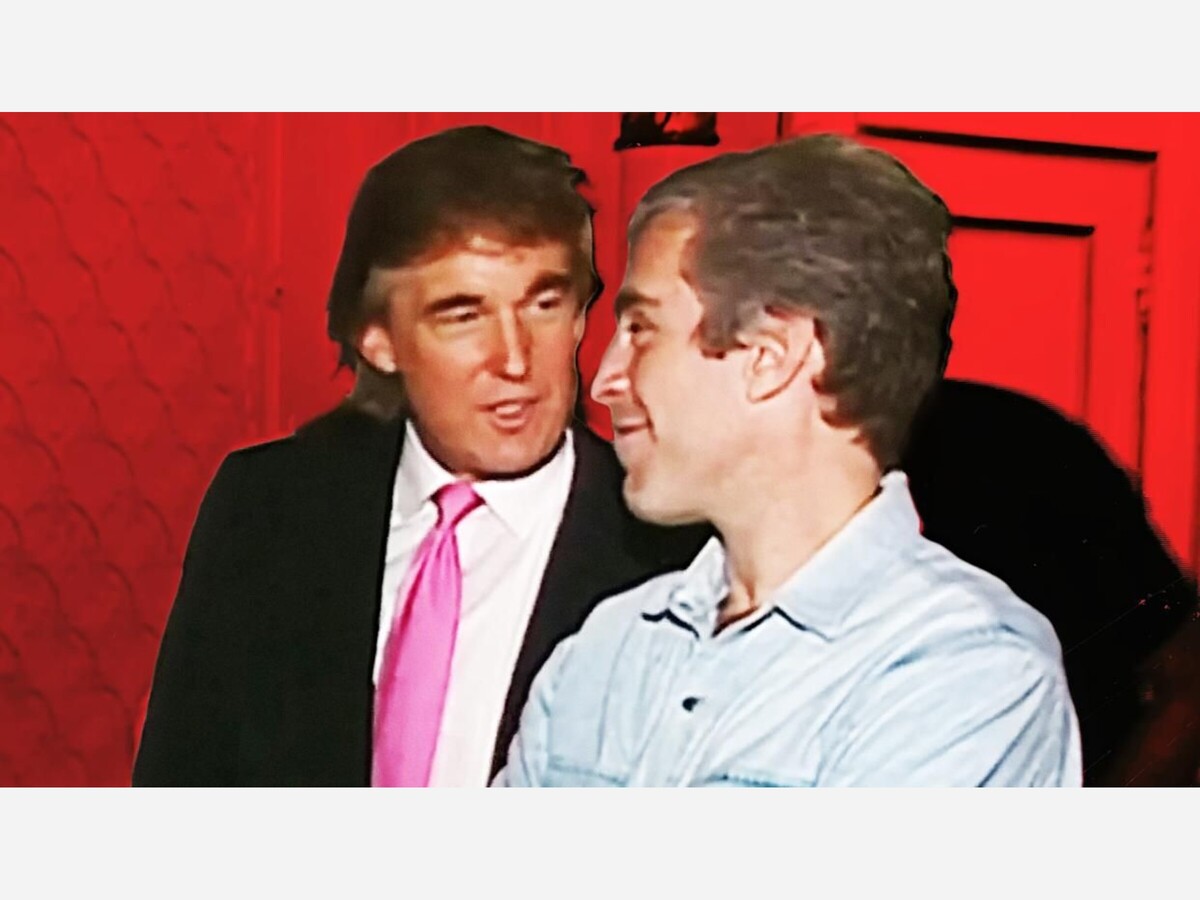

Per a request from our readers and streaming listeners AlamogordoTownNews.org and NewMexcicoConservativeNews.com tasked our intern with assisting in procuring documentation related to Jeffrey Epstein’s activities in New Mexico so we could help craft a timeline of his activities in our great state.
Jeffrey Epstein and his faciliating convicted female companion Maxwell, centered their illegal activities on the sprawling Zorro Ranch estate.
Their cases of significant criminal behaviors presents a stark case study in the intersection of criminal behavior, powerful social networks, legal loopholes, regulatory failures, and public controversy. While cities such as Palm Beach and New York have attracted the majority of media and legal scrutiny regarding Epstein, his New Mexico operation—marked by secrecy, remote geography, and state-specific legal ambiguities—raises unique questions about how local and state authorities handled Epstein before, during, and after national sex abuse allegations came to light.
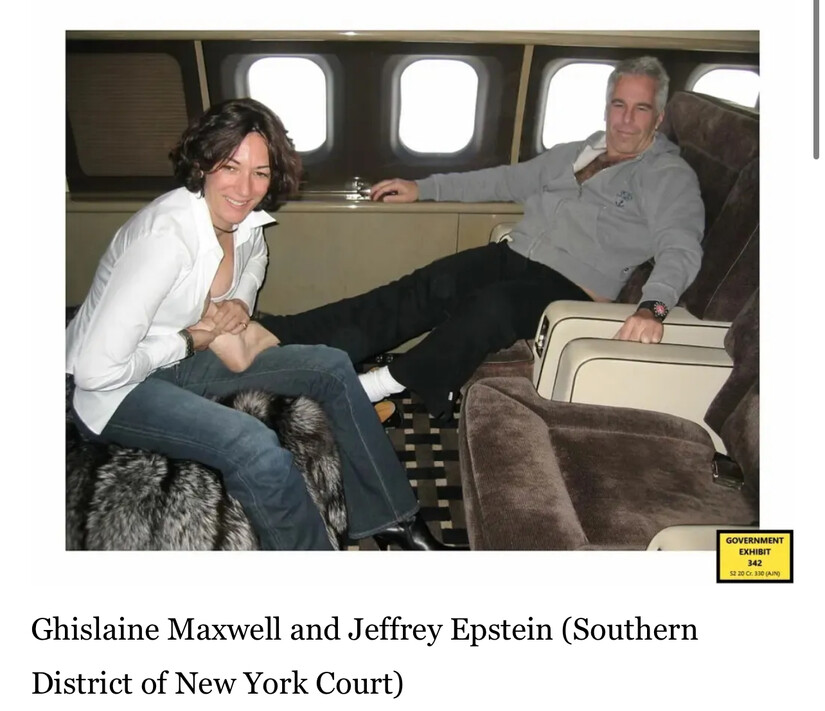
This special NewMexicoConservativeNews.com in partnership with AlamogordoTownNews.org and the research skillls of our researcher and political science intern, Mica Maynard delves into the legal and political landscape surrounding Epstein’s New Mexico presence.
This report synthesizes investigative reporting, unsealed court documents, government records, and recent analyses to examine: the acquisition and administration of Zorro Ranch; state land lease controversies; sex offender registry complications; efforts, and limitations, of law enforcement investigations; the influence of political donations; key aspects of property infrastructure; and the evolving legal and political response to Epstein’s legacy in New Mexico. Finally, it interrogates whether missed opportunities and systemic weaknesses contributed to a failure of oversight and accountability.
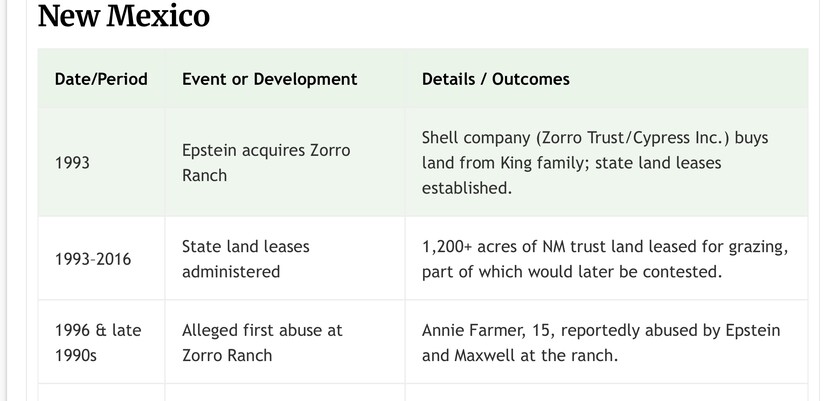
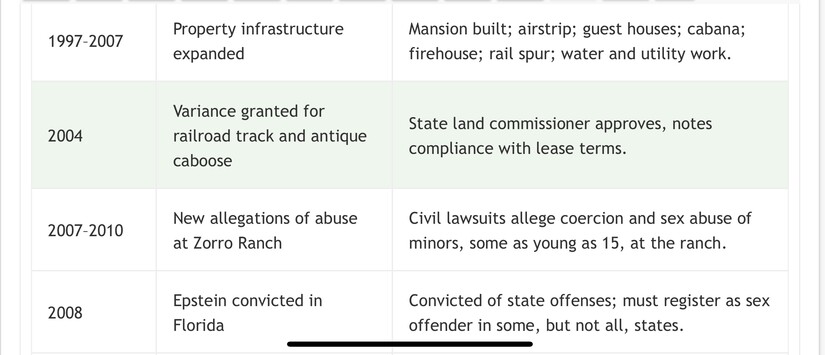
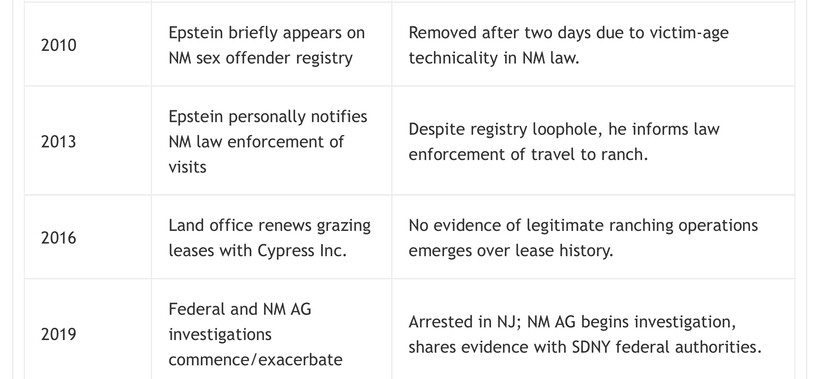

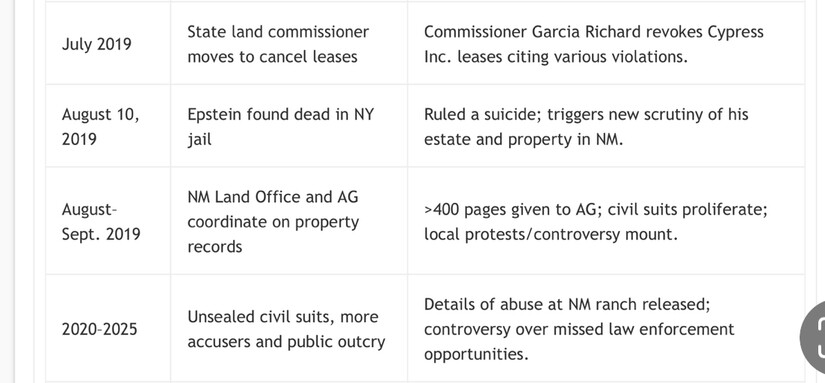
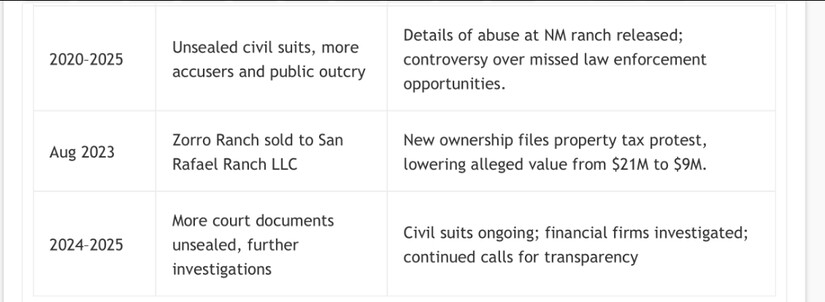
The timeline above illustrates key benchmarks in the legal, political, and investigative chronicle of Epstein’s New Mexico activities.
Jeffrey Epstein’s entry into New Mexico was facilitated by a network of shell companies and opaque trust arrangements, a hallmark of his wider operations. In February 1993, Epstein’s Zorro Trust, which would later be renamed Cypress Inc., purchased vast acreage from the influential King family—longtime power brokers in New Mexico agriculture and politics.
By channeling the acquisition through Zorro Trust and later through Cypress Inc., Epstein ensured both privacy for his involvement and insulation from public scrutiny. Shell company structures permitted him to obscure beneficial ownership and complicate access for potential investigators. The land purchase included not only over 7,700 acres of private land, but key grazing leases on 1,200+ acres of state trust land—a recurring focal point in later legal disputes.
The Zorro Ranch property itself grew to encompass up to 10,000 acres, with an elaborate main residence exceeding 30,000 square feet, outbuildings, guest houses, a pool, and even uniquely idiosyncratic features such as a railroad spur and antique caboose. Ground and aerial reports document private airstrips, hangars, and a helipad, facilitating discreet access for guests and further hampering easy law enforcement entry4.
These developments—runways, water infrastructure, utility expansions—were sometimes undertaken with, and sometimes without, appropriate permits. Epstein’s requests to build a grass runway on state-leased land were eventually withdrawn after the land office inquired about inspections, raising suspicion about compliance with state regulations.
One of the most controversial aspects of Epstein’s New Mexico presence was his exemption from the state’s sex offender registry—a distinction not shared by Florida or New York, where he was compelled to register following his 2008 conviction for procuring a minor for prostitution.
In 2010, after registering as a sex offender in New Mexico, Epstein was notified within two days by state officials that he was not, in fact, required to remain on the registry. The reason: New Mexico’s registry statute at the time only required registration in cases involving victims younger than 16, whereas the official Florida record, questionably, reported his victim as 17. Court documents and investigative reports indicate that the actual victim was 14, but the legal paperwork submitted obfuscated this fact.
This technicality allowed Epstein to both avoid ongoing law enforcement scrutiny and more freely conduct activities at Zorro Ranch with less regulatory oversight.
Public outrage over this loophole led to legislative reforms. The state’s attorney general, legislators, and advocates pushed for changes to close gaps in the registry law. Efforts included statutory modifications to reduce the amount of time a sex offender could be in the state unregistered, and further tying NM’s registry law to requirements in other states—so that if a person was required to register elsewhere, they would also have to do so in New Mexico
New Mexico’s State Land Office, particularly under Land Commissioner Stephanie Garcia Richard, has come under both criticism and praise for its handling of Epstein’s property and its subsequent attempts to address the controversy.
The original agricultural leases with Cypress Inc. date from the late 1990s, spanning over 1,200 acres of state trust land. While ostensibly for livestock grazing, there is scant public evidence of sustained ranching or legitimate agricultural production occurring there8. In 2019, after Epstein’s arrest and death, Garcia Richard’s Land Office initiated a review. They found obstacles to inspection, written misrepresentations by Cypress Inc., and concluded—supported by the attorney general’s office—that the land was not being used for its stated purpose but as a privacy buffer to shield illicit activities on the main ranch property.
In September 2019, Garcia Richard terminated the state land leases for Zorro Ranch and Cypress Inc., citing multiple legal justifications. These included:
The cancellation effectively stripped the estate of a strategic privacy buffer, set the stage for possible repurposing of the state land, and was accompanied by statements urging that the land could be used for memorials or returned to genuine ranching purposes.
New Mexico’s attorney general’s office, led by Hector Balderas at the time of Epstein’s final arrest, launched an active investigation into Epstein’s activities at Zorro Ranch following new rounds of allegations and national scrutiny in 2019. The scope included:
However, the state investigation was handicapped by limitations inherent in old NM statutes (which lacked a relevant human trafficking law during some of Epstein’s alleged criminal period), resource constraints, and, ultimately, superseding jurisdiction by federal authorities. Internal emails reveal that the NM attorney general’s agents were told to cede the investigation when the federal Department of Justice and the FBI notified the state that overlapping investigations and prosecution would occur in New York.
Still, state files document a persistent frustration among the public (and within parts of the office). Several members of the public filed complaints about the perceived lack of visible action, and some of the AG office’s investigations, including interviews with ranch employees and service providers, were either inconclusive or redacted in publicly released documents.
Under Attorney General Raúl Torrez, the NM AG’s office pivoted its investigation toward financial firms and banks suspected of facilitating Epstein’s transactions. This has resulted in at least one resolved investigation with a financial institution, with others ongoing as of 2025.
Despite Zorro Ranch’s size and strange reputation among locals—many of whom speculated about the property’s purpose, but reported few direct interactions—there is scant evidence that the Santa Fe County Sheriff’s Office or local law enforcement initiated independent criminal probes before Epstein’s national scandal came to light. Reports indicate that ranch managers, not local authorities, controlled nearly all access, and that state land officials were routinely refused entry to inspect leased parcels.
In 2013, Epstein took the unusual step of voluntarily notifying law enforcement of upcoming ranch visits. While presented as a good-faith gesture, this act, combined with his registry loophole, functioned more as a legal shield than a point of vulnerability—Epstein did not face any additional local scrutiny as a result.
The combination of procedural roadblocks (lack of access to property), limited local investigation bandwidth, and ambiguities over statute applicability (given NM’s age-of-consent and registry rules) played a significant role in leaving Epstein largely undisturbed by New Mexico law enforcement during the key periods of alleged abuse.
Epstein was a prolific donor, both nationally and within New Mexico. For almost three decades, he contributed to politicians and parties—including substantial donations to major New Mexico Democrats: Governor Bill Richardson (over $50,000), Attorney General Gary King ($15,000+ directly, $35,000+ via affiliated companies in a later gubernatorial run), and Jim Baca (candidate for land commissioner, $10,000).
Most politicians who received funds from Epstein later returned the donations or donated equivalent amounts to charity following public exposure of his criminal activities. Nonetheless, Epstein’s local connections, both political and financial, have led to unending speculation about whether these ties dampened institutional scrutiny or interfered with aggressive early investigation14.
Zorro Ranch played host to a variety of high-profile figures and academics. Unsealed court records and flight logs have linked visits by celebrities, politicians, and public intellectuals to the ranch—including Bill Clinton, Prince Andrew, Alan Dershowitz, and others. Many, including Richardson, have denied any wrongdoing or knowledge of underage abuse, but their associations have nonetheless figured prominently in subsequent controversy
A series of unsealed court documents related to civil suits brought by Virginia Giuffre and other survivors against Ghislaine Maxwell pertain directly to alleged incidents at Zorro Ranch. These filings report sexual abuse, sometimes under force or coercion, involving individuals as young as 15, arranged “massages” that were actually sexual acts supplied for wealthy guests, and photographic documentation of abuse18.
Some of these suits directly named prominent figures such as Richardson, Clinton, and Alan Dershowitz as guests who allegedly received or solicited sexual services—allegations each figure has denied, and which, in several cases, were not accompanied by direct evidence of criminality in New Mexico, but did amplify persistent public concern about local jurisdiction failures.
The eventual conviction of Maxwell for sex trafficking, and the open status of several other civil claims by alleged victims, mean that new revelations involving Zorro Ranch may still emerge. As of 2025, litigation related to Epstein’s New Mexico activities continues, with further document unsealing and possible appeals pending.
Epstein’s well-documented use of private aircraft—broadly associated with his criminal enterprise—also played a significant role in New Mexico. State investigation records include over 100 pages of flight logs between late 1997 and 2006, documenting more than 90 flights to or from New Mexico destinations using multiple aircraft.
Flight logs feature both initials (“JE” for Epstein, “GM” for Ghislaine Maxwell) and unnamed adult or female passengers, as well as other individuals linked to later-unsealed allegations. Aircraft use made law enforcement tracking difficult, as many individuals arriving or departing Zorro Ranch were not required to provide ID for private air lands.
The extraordinary scale and unique amenities on Zorro Ranch stand out, even by the standards of wealthy landowners in the American West. The property’s infrastructure was functionally designed for both privacy and luxury, serving a clientele and set of purposes well beyond those of a conventional working ranch.
Epstein employed various infrastructure projects as part of his strategy for privacy and exclusivity: the main runway—constructed on his own deeded land rather than state land after permit requests prompted scrutiny; mansion and rail developments were carried out with only sporadic or insufficient oversight from local authorities conflicted between economic benefit and ethical responsibilities.
Records uncovered by the AG and land office reveal that required agricultural activity (such as grazing) was mostly a fiction, an oft-cited example of regulatory failure. Multiple state filings noted the lack of cattle or agricultural activity, confirming suspicions that the land’s primary function was not ranching but the seclusion of Epstein’s enterprise from public view.
Following Epstein’s death and public condemnation of his activities, Zorro Ranch was placed on the market for $27.5 million in 2021. The property ultimately sold in August 2023 to San Rafael Ranch LLC for an undisclosed sum, a figure likely below the initial asking price21.
San Rafael Ranch LLC soon protested the county’s property tax assessment, arguing that the current value—set at over $21 million—was far too high, instead listing a value closer to $9 million. The issue remains unresolved as of mid-2025, with potential broader implications for county budgeting and policy about extraordinary luxury estates previously owned by scandalized figures.
Media coverage—both local and national—has been instrumental in exposing the failures of local oversight, surfacing new victim accounts, and generating political momentum for legal change. Outlets like KOAT, KRQE, CBS, and the New Republic, along with legal filings and unsealed court documents, have kept the New Mexico chapter in Epstein’s saga in the public consciousness.
Despite these efforts, some of the most vital details about the full scope of Epstein’s activities in New Mexico, especially those potentially implicating powerful people, remain shrouded in redacted records or sealed testimony. The continued redaction of key names in flight logs, and non-disclosure of certain federal investigative files, have prompted calls for more comprehensive transparency from advocates, politicians, and a frustrated public.
Retrospectively, a confluence of legal loopholes, incomplete or delayed investigations, and a culture of deference to the powerful allowed Epstein to maintain a base of operations in New Mexico—one used, by multiple credible accounts, for the exploitation and abuse of minors—almost entirely free from local scrutiny until his criminal empire collapsed on the national stage.
Failures to require registry, to audit or meaningfully inspect state-leased land, and to investigate repeated allegations (including from women and girls as young as 15) all point to a systemic deficit, only partly attributable to statutory gaps. Political connections and donation networks may have contributed to a broader reticence among some state officials, though there is no evidence that any donations directly halted investigations.
In the last five years, New Mexico has made notable progress: closing registry loopholes, canceling leases, and pursuing investigations of banks and other facilitators. Yet ongoing legal battles—including property value disputes, civil suits, and federal FOIA actions—demonstrate both the complexity and the incomplete closure of the state’s reckoning with Epstein’s abuses.
Jeffrey Epstein’s New Mexico chapter, centered on Zorro Ranch, serves as a telling case about the vulnerabilities of local jurisdictions to predatory actors possessing money, legal sophistication, social influence, and the savvy to exploit gaps in law and institutional vigilance. Despite tangible progress since 2019, the events at Zorro Ranch remind us that even the most grotesque crimes can, for years, be shielded by technicalities, bureaucratic inertia, and structures designed to favor the secretive and wealthy over the vulnerable.
Key lessons for New Mexico and other states include the critical importance of harmonizing registry laws, strengthening enforcement of public trust land use, imposing transparency requirements on political donations and land ownership, and fostering interagency coordination that does not abate even in the face of powerful resistance or legal ambiguity. The full contours of Epstein’s activities—and the systemic improvements needed to forestall future repetitions—are still emerging.
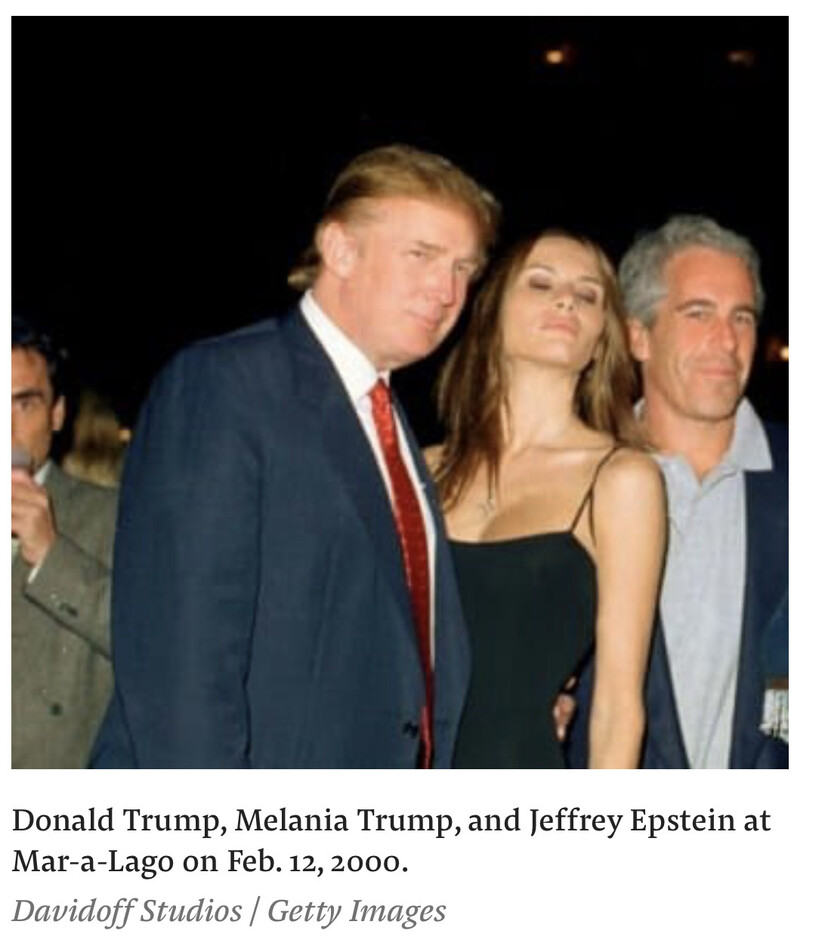
Note: This report integrates and synthesizes information from hundreds of pages of media articles, court documents, and official statements, referencing as many diverse, credible sources as possible. To learn more visit:
a useful reminder that there are, and always have been, two americas, one for the wealthy and well connected, and another for the rest of us.
the common folks deserve protection from the ability of the rich to manipulate the laws and legal systems to their advantage. perhaps some day we will see such protection....
as the english say - the rich get the gravy and the poor get the blame.